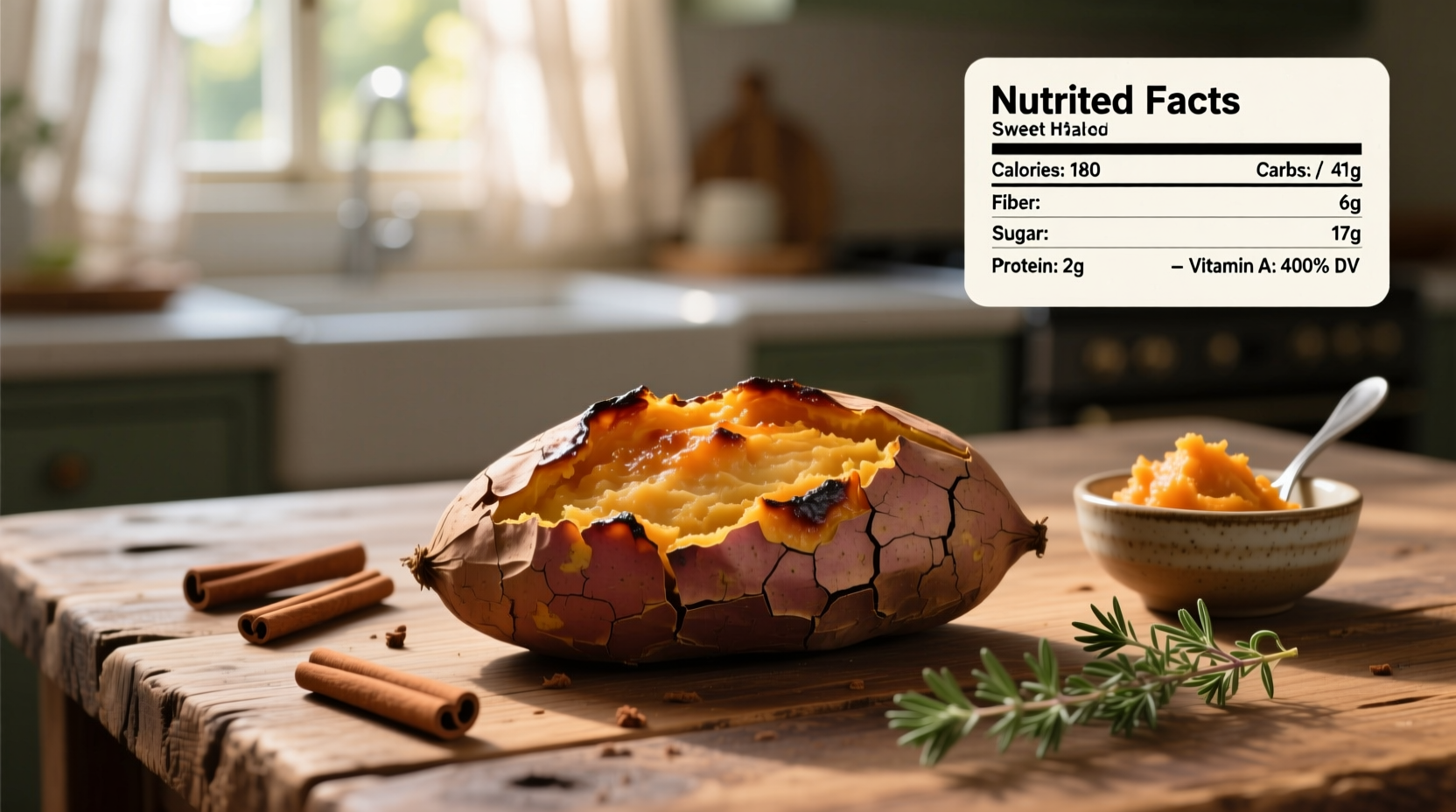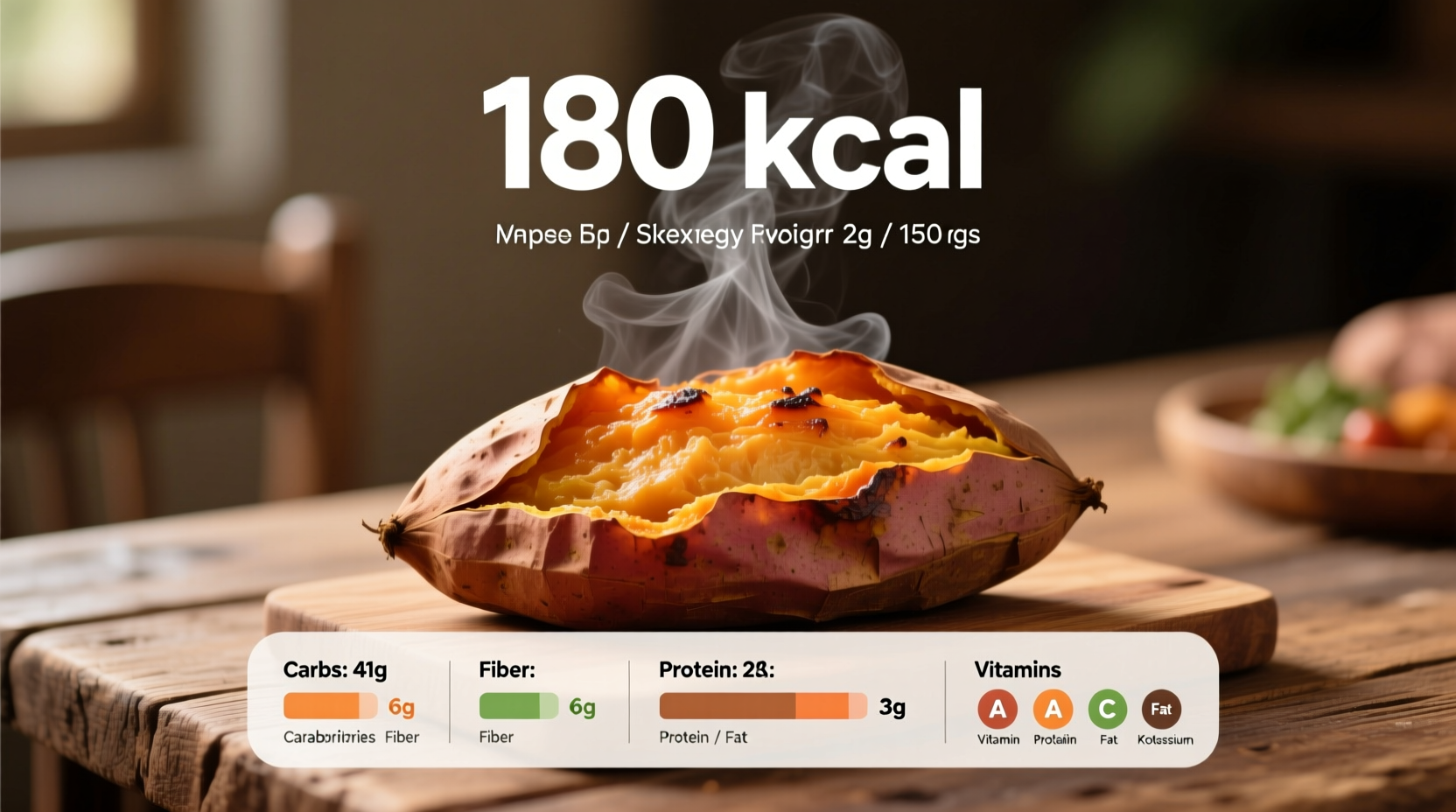Discover exactly how many calories are in a sweet potato and how preparation methods affect nutritional value. Whether you're tracking macros, managing blood sugar, or simply making healthier food choices, this guide delivers precise, science-backed information you can trust.
Understanding Sweet Potato Calorie Counts by Preparation Method
When tracking calories, preparation method significantly impacts the final count. The USDA FoodData Central database provides these verified measurements for 100-gram portions:
| Preparation Method | Calories per 100g | Key Nutritional Changes |
|---|---|---|
| Raw | 86 | Higher resistant starch content |
| Baked | 90 | Natural sugars concentrate slightly |
| Boiled | 76 | Some water-soluble nutrients leach into water |
| Mashed (no additions) | 87 | Similar to baked but slightly more digestible |
This comparison reveals an important truth: boiling sweet potatoes preserves the lowest calorie count while maintaining most nutrients. Baking concentrates natural sugars slightly but enhances beta-carotene availability. The preparation method you choose should align with your specific health goals.
Portion Size Matters: Real-World Calorie Examples
Understanding standard portions helps apply this information practically. Here's what common serving sizes look like:
- Small sweet potato (80g): 69 calories - perfect for snack portions
- Medium sweet potato (130g): 103 calories - standard single serving
- Large sweet potato (180g): 144 calories - common restaurant portion
- 1 cup cubed (150g): 114 calories - ideal for meal prep
Notice how portion size dramatically affects total calories. Many people unintentionally consume double the calories by selecting larger specimens. When tracking intake, weighing your sweet potatoes provides the most accurate measurement.
Nutritional Profile Beyond Calories
Sweet potatoes offer exceptional nutritional value beyond their moderate calorie count. One medium baked sweet potato delivers:
- 438% of your daily vitamin A needs (as beta-carotene)
- 37% of vitamin C requirements
- 27% of manganese needs
- 5 grams of dietary fiber (20% of daily value)
- Significant potassium and vitamin B6
This nutrient density explains why sweet potatoes consistently rank among the top functional foods in dietary guidelines. Unlike many starchy vegetables, they provide substantial vitamins and minerals per calorie. The fiber content promotes satiety, helping with weight management despite their carbohydrate content.

How Sweet Potatoes Compare to Other Common Foods
Understanding where sweet potatoes fit within your overall diet requires comparison to similar foods. Here's how they stack up against common alternatives:
| Food Item | Calories (per 100g) | Key Differences |
|---|---|---|
| Sweet potato (baked) | 90 | Higher vitamin A, more fiber |
| White potato (baked) | 93 | Higher glycemic index, less vitamin A |
| White rice (cooked) | 130 | Lower fiber, fewer vitamins |
| Quinoa (cooked) | 120 | Complete protein but higher calorie density |
This comparison shows sweet potatoes offer superior nutrient density compared to many common carbohydrate sources. While white potatoes have similar calorie counts, sweet potatoes provide dramatically more vitamin A and fiber. When considering how many calories in a sweet potato versus other staples, the nutritional advantages become clear.
Practical Applications for Different Dietary Goals
How you incorporate sweet potatoes depends on your specific health objectives:
For Weight Management
Include sweet potatoes as your primary carbohydrate source at lunch rather than dinner. Their high fiber content promotes fullness throughout the day. A medium sweet potato (103 calories) makes an excellent base for protein-rich toppings like black beans or grilled chicken.
For Blood Sugar Control
Pair sweet potatoes with healthy fats and proteins to moderate glycemic response. Boiling rather than baking maintains a lower glycemic index. The American Diabetes Association recognizes sweet potatoes as a diabetes-friendly food when portion-controlled.
For Athletes and Active Individuals
Time sweet potato consumption around workouts for optimal energy. The complex carbohydrates provide sustained fuel without the blood sugar spikes of refined carbs. Many sports nutritionists recommend sweet potatoes as part of pre- and post-workout meals.
Common Misconceptions About Sweet Potato Calories
Several myths persist about sweet potato nutrition that deserve clarification:
- "Sweet potatoes are too high in sugar for diabetics" - Research from the American Journal of Clinical Nutrition shows sweet potatoes have a moderate glycemic index (44-60) and can be part of diabetes management when portion-controlled.
- "All preparation methods yield similar calories" - As shown in our data table, boiling reduces calories by 15% compared to baking due to water absorption.
- "Sweet potato fries are just as healthy as whole sweet potatoes" - Commercial sweet potato fries often contain 2-3 times more calories due to added oils and sugars.
These clarifications help you make informed decisions based on actual nutritional science rather than popular misconceptions.
Maximizing Nutritional Benefits While Managing Calories
Follow these evidence-based strategies to get the most from sweet potatoes:
- Leave the skin on - The skin contains additional fiber and nutrients while adding negligible calories
- Pair with healthy fats - A small amount of olive oil or avocado enhances absorption of fat-soluble vitamins
- Avoid sugary toppings - Marshmallows or brown sugar can double the calorie count of your serving
- Try cooling after cooking - Refrigerating cooked sweet potatoes increases resistant starch content by up to 50%
These practical tips help maintain the impressive nutrient profile while keeping calorie counts predictable. Remember that how many calories in a sweet potato ultimately depends on your specific preparation choices.
Frequently Asked Questions
How many calories in a sweet potato with skin versus without skin?
The skin adds minimal calories but significant fiber. A medium sweet potato with skin contains approximately 103 calories, while peeled it contains about 99 calories. The 4-calorie difference is negligible, but the skin provides an additional 1-2 grams of dietary fiber and valuable antioxidants.
Do sweet potatoes have more calories than white potatoes?
Actually, sweet potatoes contain slightly fewer calories than white potatoes by weight. A 100g serving of baked sweet potato has 90 calories compared to 93 calories for white potato. However, sweet potatoes provide substantially more vitamin A and fiber, making them more nutrient-dense despite the similar calorie count.
How does cooking method affect sweet potato calorie density?
Boiling reduces calorie density to 76 calories per 100g as the potato absorbs water. Baking concentrates natural sugars slightly, resulting in 90 calories per 100g. Frying dramatically increases calories to 160+ per 100g due to oil absorption. For lowest calorie preparation, boiling without added fats is optimal.
Are sweet potatoes good for weight loss despite their carbohydrate content?
Yes, sweet potatoes can support weight loss due to their high fiber content (5g per medium potato) which promotes satiety. Research published in the Journal of Nutrition shows that the resistant starch in sweet potatoes helps regulate appetite. Their moderate calorie count (103 calories for medium size) makes them an excellent carbohydrate source when portion-controlled.
How many calories in a cup of mashed sweet potatoes?
One cup (200g) of plain mashed sweet potatoes contains approximately 174 calories. This assumes no added milk, butter, or sweeteners. Commercially prepared mashed sweet potatoes often contain significantly more calories due to added fats and sugars, sometimes reaching 250+ calories per cup.











 浙公网安备
33010002000092号
浙公网安备
33010002000092号 浙B2-20120091-4
浙B2-20120091-4